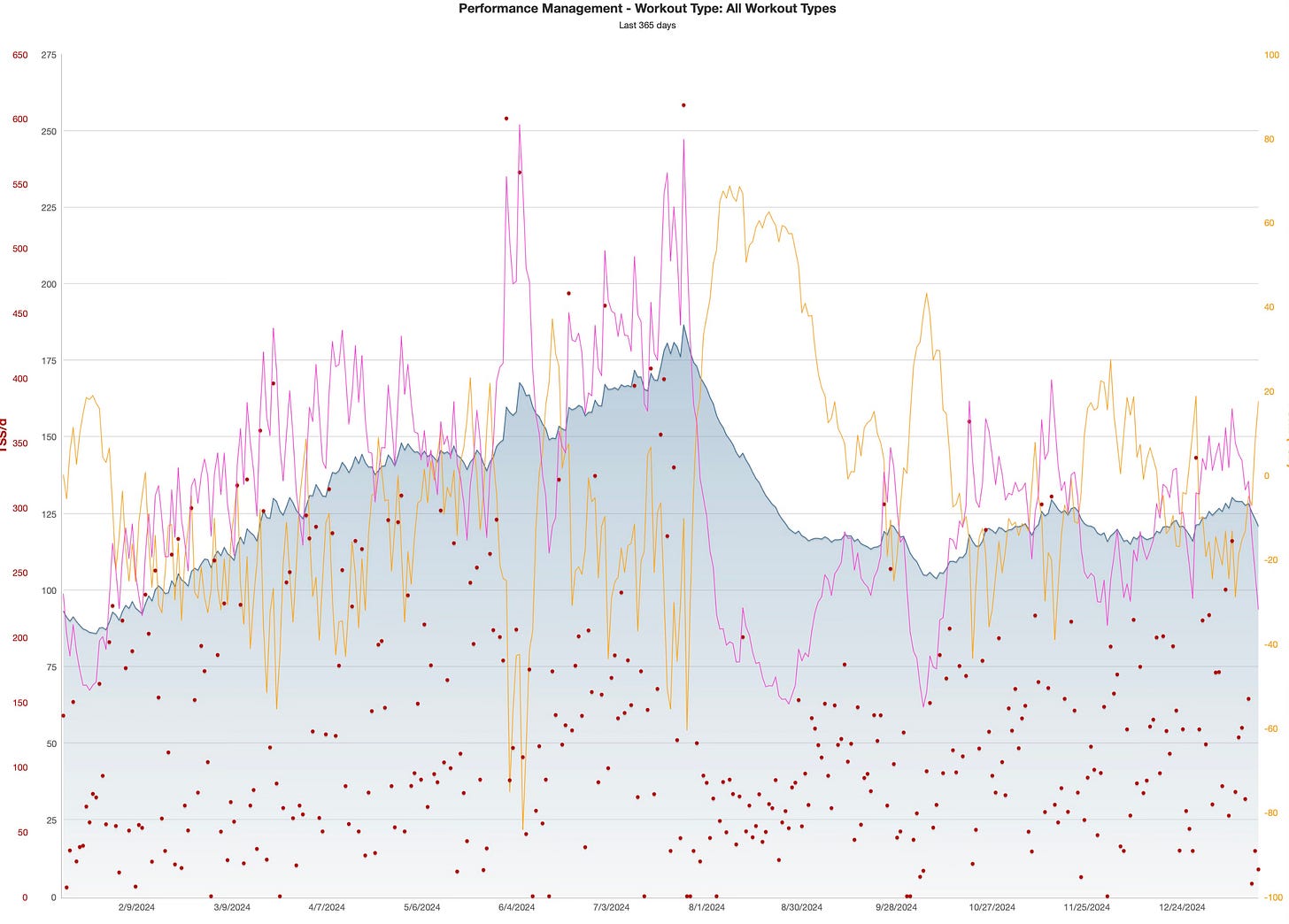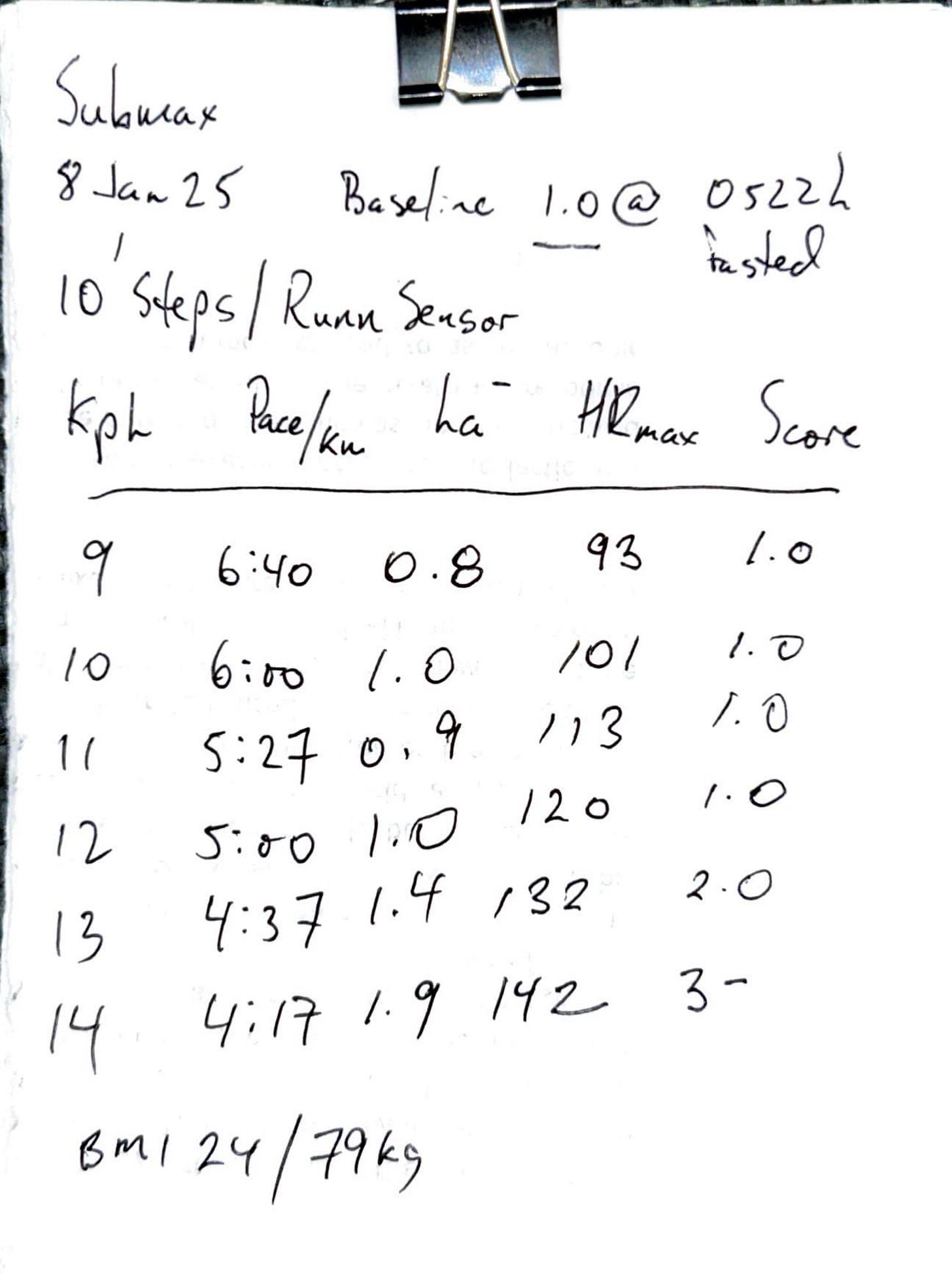Had a 2025-kickoff meeting with Julie. She came up with excellent ideas I wanted to document, and share with you.
Recovery
I rarely take more than two days off running (or any sport) in a row, Frequency is a key training target. Given a recent injury, and a desire to get more specific in my run training, Julie recommended I consider five days off running, in a row, every 4th week.
This reminded me of a strategy I used with my masters Ironman athletes. With them, we would operate on a 21-day loading cycle with Monday to Friday of the third week done easy. It was a “16 days on” and “5 days off” periodization strategy, with additional easy days mixed into the “16.” The 21-day cycle allowed a loading weekend, every weekend, but avoided getting run down.
As I’ve said before, across the year, half my days are easy days. Julie’s suggested change would place more easy days into my competitive season. It will also slow my CTL ramp (blue line below), which was extreme in 2024.
Swim
My swimming has been going great. No changes from my current plan which has been:
Monday - Squad Endurance & Strength (5,000 m), Sleeveless Wetsuit
Wednesday - Solo Endurance (3,000 to 4,000 m), No Flotation
Friday - Solo or Squad Strength (5,000 m), Flotation based on fatigue
Weekend - Easy Swim (2,500 m), No Flotation
I’ve been avoiding the Tuesday/Thursday squad swims as they were leaving me too tired, relative to the benefit I was receiving. As well, the pool water was hot last summer so I was getting cooked doing sustained swimming with the group.
Bike
If you’ve been reading Gordo’s Guide to Going Long then you’ll have seen the key challenge for amateur Ironman is being able to tolerate the workload required on the bike. Julie and I are on the same page and she had suggestions that mirror my approach.
Back-end load the work during the long ride. An example would be riding 2,500 kJ on the road bike (outdoors, hills) then getting on the trainer for a solid TT set of 1,000 to 1,500 kJ. This is a variation of a Craig Alexander workout and something Dave Scott would have me do as a pro. Back then, the roads were less crowded so I’d do the full session outside.
Use intervals to manage fatigue. At 56, I recover much slower than 15 years ago. So use intervals to break up the stress, while getting the work done. Don’t put pressure on yourself for continuous riding. Use a progression (in winter) of 8x10’, 4x20’, 2x40’ then 80’ - those are separate sessions, not a single workout. Rest intervals are short (1 to 2 minutes), just a mental break and a chance to sample lactate. I’ve been doing this informally on Zwift with up to 60 minutes of LT1 riding. For targeting, I need to refresh my Submax Testing data and do some spot checking.1
New Torque Sets: Julie’s Tempo and High-Torque progressions are included in our Cycling Chapter. These worked great last year. I saw my FTP rise by ~30w between the Spring and the Summer - huge gains. Thing is… the high-torque main sets were so tough they disrupted my swim and run training. This wasn’t a problem in 2024 because my goal race was Alpe Tri - a bike-heavy event.
I asked Julie for ideas to reduce the dose of the bike main sets. Julie’s sending me a protocol she tried with her other athletes (last year). It’s shorter duration, higher power efforts. When I try them, I’ll report back on Endurance Essentials.
Run
With my recent injury (Satorius overuse), I’ve decided to cap my chronic run load at ~50km per week. Julie said… well then, we’ll need to make the sessions count. I think I’m ready for that.
LT1 running: with my recent testing, 4:25-4:40 k pace has come into my Green Zone and my metabolic testing shows my fatox strong all the way to ~4:15 k pace. I will be experimenting with blocks of ~4:35 k pace, which is significantly quicker than the ~5 min per K pace I use for most my endurance runs.
As a young elite, I’ve made this change before. Then, and now, the change was indicated by RPE and lactate testing. What remains to be seen… my Zone 2 load tolerance at 56 vs 33 years old.
October to December surfaced two limiters with my faster running: neuromuscular quickness and force/power at high velocity. My central fitness remains strong.
Neuromuscular Improvement: use the treadmill to get leg turnover up. Sessions like 10x 30:30 off the bike and 20x 1:1 as a stand alone set. I could even do 12-15x 15” extremely fast as a short session to warm-up before a challenging bike session.
Force/Power Improvement: continue building on the hill rep work I did in Q4 2024.
Specific Preparation: given I’m likely to be recovery limited during specific preparation, consider a session (that sounded very Norwegian). 10-16x 800m holding Open Half Marathon Pace with 1 minute passive recovery after each rep. The idea is to hold Threshold velocity but only generate Tempo lactate/stress. This sounded interesting. I like it because it will be faster than Ironman race pace but shouldn’t disrupt my week as much as my classic 6-10x 800m workout; where I seek to hold 10K to 5K pace. The Half-Marathon 800s will be placed in April and May.
Races & Camps
Travel (mainly) for camps, rather than races.
A winter camp in Tucson.
A spring camp in Tucson.
Oceanside 70.3 in April.
Two-week camp in Italy (May), followed by updated lab testing in Helsinki.
More racing in June. Colorado Triathlon (Olympic, June 7, 4 weeks out) and Boulder 70.3 (June 14, 3 weeks out). Race strategy based on how training is going.
Race-Simulation Events done 2, 5 and 11 weeks out from Challenge Roth on July 6th. These could be adjusted as I’ve done long rides/big days before races to get an “Ironman Stimulus” from the race.
All of this is explained, more generally, inside this Saturday’s video. You can subscribe to my YouTube Channel here.
A Word of Thanks & Future Studies
If you got this far then you’re likely a big supporter of mine. So thank you.
Last year, I used the money from the Paid List (True Wealth & Endurance Essentials) for doubly-labelled water testing (see The Burn Series) as well as purchasing two Calibre portable testing units.
The Calibre unit didn’t work out as the mask is uncomfortable and I wasn’t able to get stable readings. My buddy, Alan Couzens, had more luck tracking his VO2 and Tidal Volume. You can ask him about it on his forum (open to the public for a nominal fee).
Those of you who follow Olav Aleksander Bu will have heard him say that Kristian Blummenfelt saw his relative VO2max decline when he lost weight. This is highly unusual in endurance sport. It has been taken as a given that VO2 “per kilo” (ie relative VO2) will increase when we lose weight. Less kilos… more VO2 per kilo. Seems that might not be the case, at least for Kristian.
So this year’s project will be doing the same experiment on myself (I’m at peak winter weight as I type this). While I don’t have ~$50,000 for a metabolic cart, thanks to the Paid List, I have enough to purchase a VO2Master unit. My references indicate that, with careful calibration and indoor usage, I will be able to get reliable and repeatable VO2 data from the unit.
Follow me on X or keep an eye on my Instagram story for previews of the results.
If you read my stuff last year then you saw I thought I had a gap between my kick’r bike power and the readings I saw outside on my Favero power pedals. I did a test set and power lines up well. What I was feeling was a change in RPE (and fitness, perhaps) between winter/indoor and summer/outdoor. Like John wrote in our Zones Chapter, some athletes will different zones indoor vs outdoor. Seems like I’m one of those athletes.






Hey Gordo, I’ve been reading your Substack for what seems like 2 years now?? Crazy. Please keep the content coming it’s great. My question for you is are you factoring in your strength work into your TSS on your PMC?
Great details. Thanks